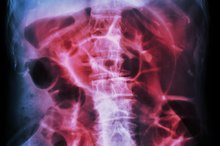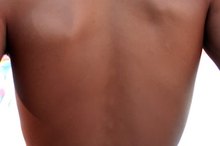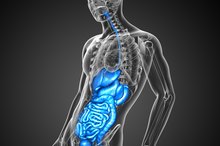What Are the Causes of a Long Redundant Colon?
Colons vary in shape and size. While all colons have loops, a redundant colon consists of extra loops which cause it to be longer than normal. The extra loops in the colon may have developed naturally or as the result of factors such as stress, toxins or dietary issues.
If you are experiencing serious medical symptoms, seek emergency treatment immediately.
Constipation and Dietary Issues
The most probable cause of redundant colon is constipation. Putting pressure on the colon by straining for a bowel movement twists the colon causing obstruction, swelling or misshaping of the large intestine. Because constipation results from an imbalanced, fiber-deficient diet, prevention of constipation and the resulting problems like redundant colon can be addressed by following a diet that includes healthy fats and plenty of whole grains.
- The most probable cause of redundant colon is constipation.
- Because constipation results from an imbalanced, fiber-deficient diet, prevention of constipation and the resulting problems like redundant colon can be addressed by following a diet that includes healthy fats and plenty of whole grains.
Stress
Distended Colon Symptoms
Learn More
Because stress can lead to infrequent bowel movements, this can be another contributing factor in the development of constipation and, possibly, redundant colon.
Toxins and Pathogenic Organisms
Pathogenic organisms in the body contribute to redundant colon by causing illness, disease, and other health issues 1. If toxins and bacteria remain in the colon too long, they can contaminate the fecal matter and cause colon obstruction 1.
Warning
Tortuous Colon Symptoms
Learn More
The term redundant colon is often confused with the term "twisted colon," or volvulus, which is actually a much more serious issue. While someone may be born with a long or redundant colon, a twisted colon occurs when the colon begins to twist around itself 1. This causes cramping, abdominal pain, a distended belly and usually requires immediate medical attention.
Related Articles
References
- Colon Cancer Digestion Health Zone: Addressing a Twisted Colon
- Hermann J, Karmelita-katulska K, Paszkowski J, Drews M, Stajgis M. Diagnosis of a cecal tumour with virtual colonoscopy. Pol J Radiol. 2011;76(2):25-7.
- Carethers JM. Risk factors for colon location of cancer. Transl Gastroenterol Hepatol. 2018;3:76. doi:10.21037/tgh.2018.09.15.
- Kunzmann AT, Coleman HG, Huang WY, Kitahara CM, Cantwell MM, Berndt SI. Dietary fiber intake and risk of colorectal cancer and incident and recurrent adenoma in the Prostate, Lung, Colorectal, and Ovarian Cancer Screening Trial. Am J Clin Nutr. 2015;102(4):881-90. doi: 10.3945/ajcn.115.113282.
- Aykan NF. Red meat and colorectal cancer. Oncol Rev. 2015;9(1):288. doi:10.4081/oncol.2015.288.
- Rossi M, Jahanzaib anwar M, Usman A, Keshavarzian A, Bishehsari F. Colorectal cancer and alcohol consumption-populations to molecules. Cancers (Basel). 2018;10(2). doi:10.3390/cancers10020038.
- American Cancer Society. (2006). American Cancer Society’s Complete Guide to Colorectal Cancer. Clifton Fields, NE: American Cancer Society.
- Harvard School of Public Health. (n.d.). Protein: What Should I Eat?
- Witmer, L. (2007, January 23). Clinical anatomy of the large intestine.
Writer Bio
Nicole Gordon is a graduate from the University of Central Florida and has been a freelance writer for over seven years. During her freelance career Gordon has written for such publications as the Orlando Sentinel online, Axis magazine and various other websites.







